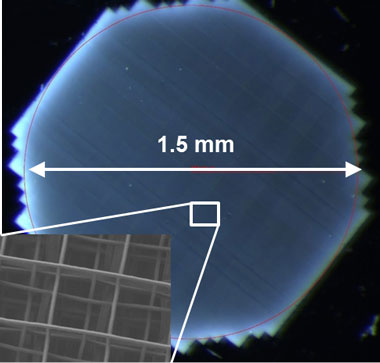Juergen Biener (15-ERD-019)
Project Description
Multiscale porous materials with tailored density, morphology, and composition have recently attracted interest in the material science community because of their many promising applications ranging from high-energy-density physics and shock absorption to catalysis and energy storage and conversion. However, despite the progress that has been made in nanometer-scale materials synthesis and in the field of engineered microscopic lattices, there still remains a length-scale gap that separates true nanomaterials from engineered microstructures, thus preventing us from taking full advantage of the potential of these multiscale materials. We intend to bridge this gap by combining additive manufacturing technologies with nature's principles of self-organization, self-assembly, and template capability. Specifically, we hope to enable development and tooling-free integration of monolithic, low-density porous carbons with sub-micrometer feature size, tailored anisotropic morphologies, and uniaxial density gradients. We will integrate LLNL's additive manufacturing technologies and nanometer-scale materials synthesis capabilities, which has the potential to improve the reproducibility of high-energy-density and Inertial Confinement Fusion target fabrication, as well as enable new concepts for mitigating hydrodynamic-instability growth in laser Inertial Confinement Fusion.
If successful, we will develop monolithic millimeter-sized, graded low-density carbon-based foam materials with sub-micrometer feature size that offer deterministic control over uniaxial density profiles where the density changes by a factor of ten. We expect to achieve sub-micrometer resolution, improving that of existing additive manufacturing technologies as well as integrating emerging, high-resolution technologies. In addition, we will develop tailored additive manufacturing feedstock materials with built-in porosity and length-scale control, as well as integrate template approaches. Our research has the potential to greatly improve the reproducibility of laser fusion target fabrication, provide new concepts for mitigating hydrodynamic-instability growth for fusion targets, and reduce the time associated with the development cycle for these targets. The proposed new materials capability also has the potential to create a pathway towards porous structures that mimic nature's functional filtration organs such as the kidney and liver, as well as enable new energy storage and conversion concepts.
Mission Relevance
Monolithic multiscale porous materials with tailored mass transport properties are the future of high-energy-density physics target fabrication and are expected to enable transformational large-scale electrical energy storage solutions. Our research project to integrate additive manufacturing technologies and nanometer-scale materials synthesis capabilities is well aligned with Livermore's core competency in advanced materials and manufacturing. In addition, the research supports the scientific needs of the Laboratory's stockpile stewardship science and energy and climate security strategic focus areas.
FY16 Accomplishments and Results
We made significant progress in all areas of work proposed for FY16. Specifically, we (1) produced the first additive manufactured foam reservoirs (single, stepped, and graded-density "log-pile" structures) and integrated them into targets for the first ramp-drive material strength tests at the OMEGA laser facility in Rochester, New York, as shown in the figure; (2) determined that the targets performed in good agreement with prediction; (3) developed characterization techniques for quantitative characterization of density and uniformity; (4) developed strategies to convert the printed polymer structures into pure carbon foams (using nickel as a catalyst for conversion to graphite) or ultralow-density metal oxide foams (templates with atomic layer deposition); and (5) developed processes to mitigate anisotropic shrinkage and to strengthen the printed polymer structures by radial-induced cross-linking.
Publications and Presentations
- Oakdale, J. S., "Post-print UV curing method for improving the mechanical properties of prototypes derived from two-photon lithography." Optic. Exp. 24(24), 27077 (2016). LLNL-JRNL-702799. https://doi.org/10.1364/OE.24.027077






